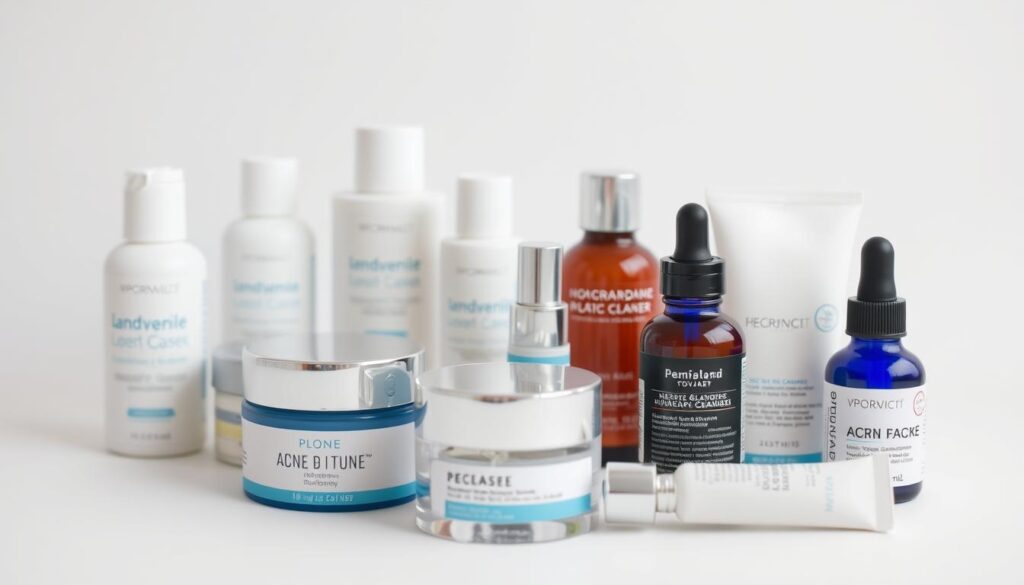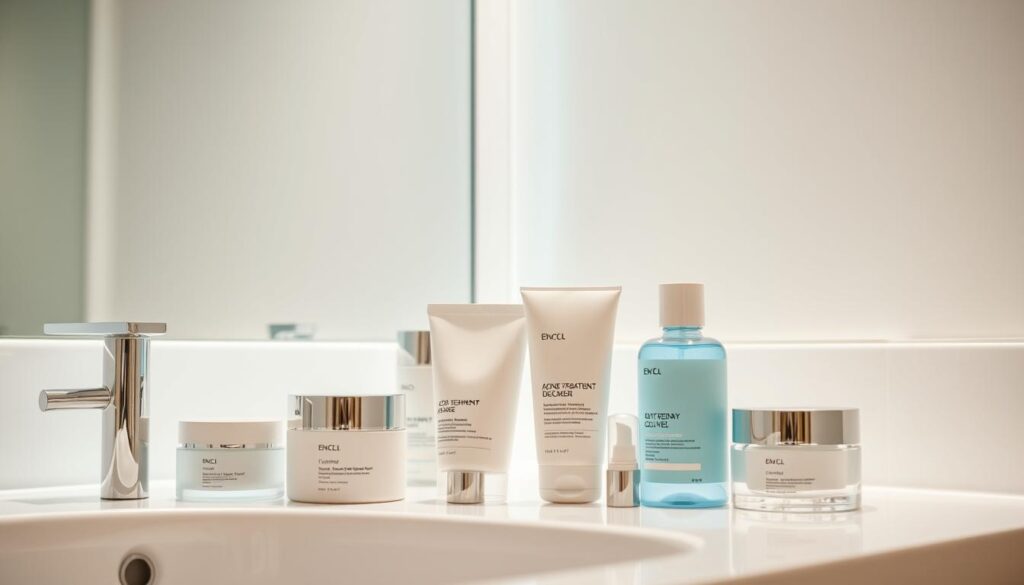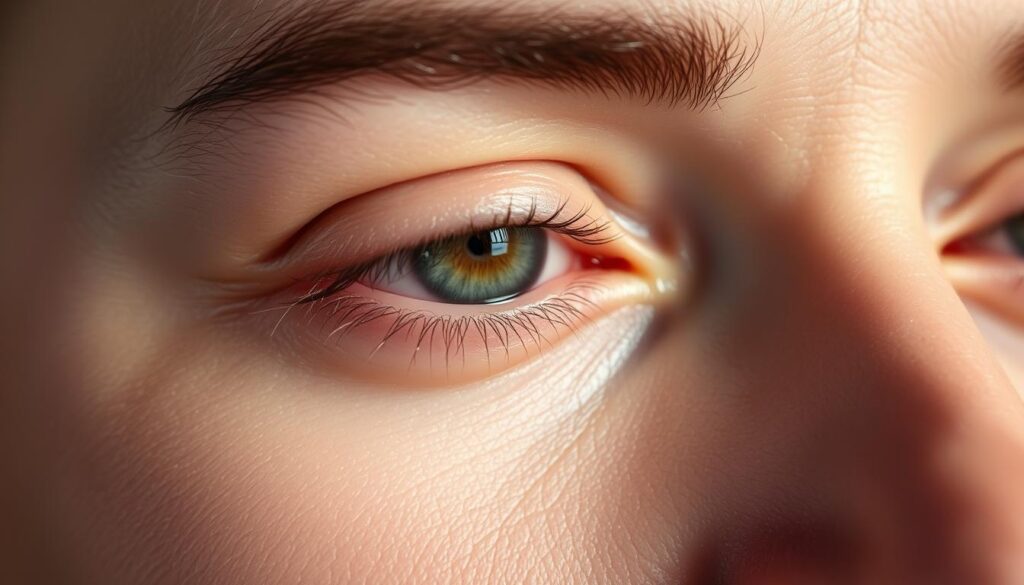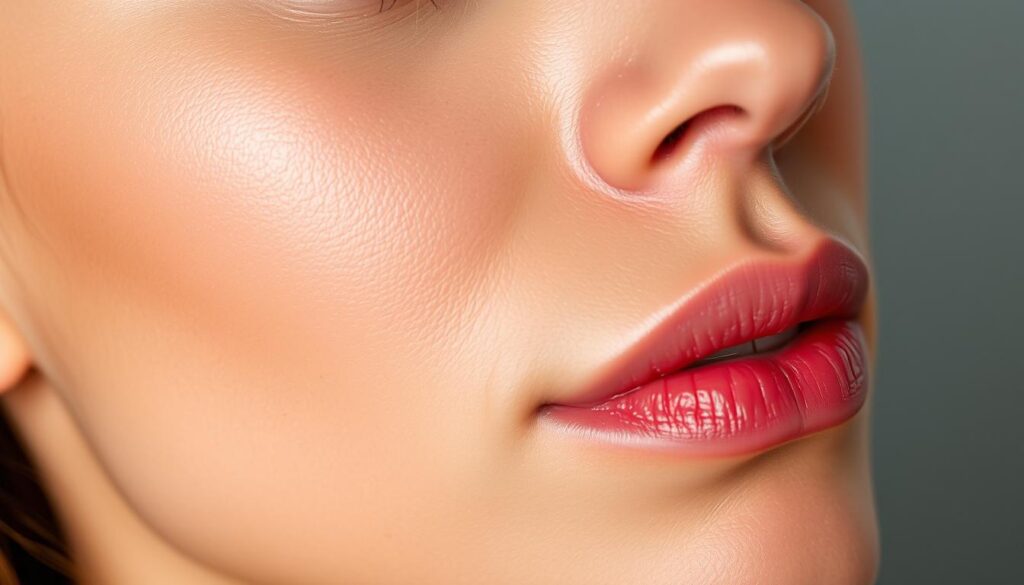Dealing with skin issues can be frustrating, especially when they affect your confidence. Acne is a common condition that impacts millions of people, particularly those aged 16 to 18, but it can persist into adulthood1. It occurs when oil, dead skin cells, and bacteria clog your pores, leading to breakouts like whiteheads, blackheads, and pimples2.
Your skin’s health is influenced by factors like hormones, stress, and even diet. Hormonal changes, especially during puberty, can increase oil production, making breakouts more likely1. While mild cases can often be managed with over-the-counter products, severe forms may require prescription treatments2.
Taking care of your skin doesn’t have to be complicated. Simple steps like using gentle cleansers, avoiding oil-based makeup, and protecting your skin from the sun can make a big difference3. With the right approach, you can manage breakouts and feel more confident in your skin.
Introduction to Acne and Healthy Skin
Your skin’s appearance often reflects its internal health and care. When pores become clogged with oil, dead skin, and bacteria, it can lead to breakouts. This is a common skin condition that affects millions worldwide4.
What is Acne and Why It Happens
Acne occurs when your pores are blocked by excess oil and dead skin cells. Bacteria thrive in this environment, causing inflammation and pimples. Hormonal changes, especially during puberty, play a significant role in increasing oil production4.
Common symptoms include whiteheads, blackheads, and red bumps. These can appear on your face, neck, shoulders, and back. While mild cases are manageable, severe forms may require medical attention5.
The Impact of Acne on Your Confidence
Even minor skin issues can affect how you feel about your appearance. Breakouts can make you self-conscious, impacting your daily life. Healthy skin care routines, like using gentle cleansers and drinking enough water, can help improve your skin’s condition4.
| Skin Care Tips | Benefits |
|---|---|
| Use gentle cleansers | Removes excess oil and bacteria |
| Drink plenty of water | Keeps skin hydrated and healthy |
| Avoid oil-based products | Prevents clogged pores |
Taking small steps to care for your skin can make a big difference. With the right approach, you can maintain its health and feel more confident in your appearance.
Understanding Acne Causes: Triggers Behind Your Breakouts
Understanding what triggers breakouts can help you take control of your skin health. Many factors, from hormones to lifestyle habits, play a role in how your skin behaves. Let’s explore the key contributors to breakouts and how they affect you.
Hormonal Influences and Genetic Factors
Hormones are a major player in skin health. During puberty, increased testosterone levels can lead to excess oil production, which clogs pores and causes breakouts6. If both parents had skin issues, you’re more likely to experience severe symptoms6.
Women often face hormonal changes that trigger flare-ups. For example, about 50% report breakouts before their menstrual cycle6. Conditions like polycystic ovary syndrome (PCOS) can also worsen skin health6.
Environmental and Lifestyle Contributors
Your surroundings and habits can also impact your skin. Pollution, stress, and smoking are known to worsen breakouts6. Diets high in sugar and processed foods may increase your risk of skin issues6.
Using the right products can help. Ingredients like retinoids and salicylic acid are effective in unclogging pores and reducing inflammation. Avoiding oil-based skincare products can also prevent clogged cells7.
| Contributing Factor | Impact on Skin |
|---|---|
| Hormonal Changes | Increases oil production, leading to clogged pores |
| Genetic Predisposition | Higher likelihood of severe symptoms |
| Pollution and Stress | Worsens inflammation and breakouts |
By understanding these triggers, you can make informed choices to improve your skin’s health. Small changes in your routine can lead to clearer, healthier skin over time.
Exploring Different Types of Acne
Different forms of skin concerns require tailored approaches for better results. Understanding the specific type you’re dealing with can help you choose the right care. From mild to severe, these issues vary widely in appearance and impact.
Whiteheads, Blackheads, and Inflammatory Lesions
Non-inflammatory forms, like whiteheads and blackheads, are the most common. Blackheads occur when pores are clogged but remain open, while whiteheads are closed off. These are often mild and can be managed with over-the-counter products8.
Inflammatory lesions, such as papules and pustules, are more severe. They appear as red, swollen bumps and can be painful. Bacterial growth in clogged pores often leads to these types of breakouts9.
Adult Hormonal and Severe Acne Forms
Adult hormonal concerns are often linked to changes during menstrual cycles, pregnancy, or menopause. About 50% of women experience this at some point in their lives10. Unlike teenage issues, these forms are chronic and may require ongoing care.
Severe forms, like cystic or nodular breakouts, are painful and often leave scars. They affect about 10% of adolescents and young adults, usually needing aggressive treatments like isotretinoin10. Consulting a dermatologist is crucial for managing these cases effectively.
Comprehensive Acne Treatment Options
Effective care starts with understanding the options available for managing skin concerns. Whether you’re dealing with mild or severe breakouts, there are solutions tailored to your needs. From over-the-counter products to prescription medications, finding the right approach can help you achieve clearer skin.

Over-the-Counter and Topical Medications
For mild cases, over-the-counter products are often the first step. Ingredients like benzoyl peroxide and salicylic acid are effective in reducing bacteria and unclogging pores. Benzoyl peroxide is available in concentrations ranging from 2.5% to 10%, making it a versatile option for many11.
Salicylic acid, found in cleansers and lotions, helps remove the top layer of damaged skin. This can prevent new breakouts and improve your skin’s texture12. Retinoids, such as Differin®, are another popular choice. They require consistent use but can deliver noticeable results over time12.
Oral Treatments and Prescription Medications
For more severe cases, oral medications may be necessary. Antibiotics like tetracycline and doxycycline are often prescribed to reduce inflammation and bacteria. However, these are typically limited to a 3-month treatment to prevent antibiotic resistance11.
Prescription-strength retinoids, such as isotretinoin, are another option. This medication shrinks oil glands, significantly reducing breakouts. It’s usually prescribed for 4 to 6 months and requires close monitoring12.
If hormonal factors are contributing to your breakouts, treatments like spironolactone or hormonal contraceptives may be recommended. These can help balance hormones and improve skin health12.
When choosing a treatment, consider your specific needs and consult a dermatologist if over-the-counter options aren’t effective. With the right approach, you can manage breakouts and enjoy healthier skin.
Acne Causes and Treatments: A Complete Guide
Achieving clear skin often requires a blend of expert advice and personalized strategies. Dermatologists like Reid Maclellan, MD, emphasize that understanding your skin’s unique needs is the first step toward effective care13. This means tailoring your routine to address specific symptoms, whether they’re mild or severe.
Short-term solutions, like using benzoyl peroxide or salicylic acid, can reduce inflammation and bacteria quickly14. However, long-term results often depend on consistent habits. For example, monitoring how your skin responds to treatments helps you adjust your routine for better outcomes.
Balancing Short-Term Relief and Long-Term Solutions
Immediate relief is important, but it’s only part of the equation. Dermatologists recommend combining quick fixes with sustainable practices. For instance, oral antibiotics can reduce severe symptoms, but they’re typically limited to a 3-month course to prevent resistance15.
Long-term strategies include maintaining a gentle skincare routine and avoiding triggers like stress or poor hygiene. These habits support your skin’s health over time, reducing the likelihood of future breakouts14.
| Strategy | Benefit |
|---|---|
| Use topical retinoids | Unclogs pores and prevents new breakouts |
| Monitor symptoms | Helps adjust care routines effectively |
| Maintain hydration | Supports overall skin health |
By combining expert insights with personalized care, you can manage breakouts effectively. This balanced approach ensures both immediate relief and lasting improvements in your skin’s appearance.
Home and Natural Acne Solutions
Natural remedies can be a gentle yet effective way to manage skin concerns. Many people turn to at-home solutions to soothe and improve their complexion. These methods are often affordable, easy to use, and free from harsh chemicals.
https://www.youtube.com/watch?v=ys_R4KZYj24
DIY Remedies to Soothe Your Skin
Ingredients like green tea extract and tea tree oil are popular for their anti-inflammatory and antibacterial properties. A 2016 study showed that green tea extract reduced breakouts in women after four weeks of use16. Tea tree oil, on the other hand, has been found to be as effective as benzoyl peroxide but with less irritation17.
Other natural options include aloe vera and witch hazel. Aloe vera can calm redness and hydrate your skin, while witch hazel acts as a natural astringent. These ingredients are gentle and suitable for most skin types.
Building an Effective Skincare Routine
Creating a consistent routine is key to maintaining healthy skin. Start with a gentle cleanser to remove dirt and excess oil without stripping your skin. Over-washing can irritate your skin and worsen breakouts, so stick to cleansing twice a day18.
Incorporate natural products that suit your skin’s needs. For example, a clay mask with jojoba oil can help unclog pores and improve texture17. Finish with a lightweight moisturizer to keep your skin hydrated and balanced.
Avoid harsh chemicals and always patch-test new products. Consistency and patience are essential for seeing long-term results.
Lifestyle Adjustments for Clearer Skin
Your daily habits play a bigger role in your skin’s health than you might think. From what you eat to how you manage stress, these factors can influence breakouts and overall appearance. Making small, intentional changes can lead to noticeable improvements in your complexion.
Dietary Choices and Their Role in Breakouts
What you eat can directly affect your skin. Foods with a high glycemic index, like processed carbs and sweets, have been linked to breakouts19. While the evidence is still emerging, reducing these foods may help minimize oil production and inflammation.
Some studies suggest a weak connection between cow’s milk and breakouts, though it’s not a direct cause19. Instead, focus on nutrient-rich options like fiber and omega-3 fats, which may support healthier skin20.
Stress Management and Regular Exercise
Stress can trigger breakouts by increasing oil production through elevated cortisol levels19. Managing stress through activities like yoga, meditation, or even a daily walk can help keep your skin balanced.
Regular exercise also plays a key role. It improves blood flow, which supports skin health. Just remember to wash workout clothes frequently and use hypoallergenic detergents to avoid irritation19.
By combining these lifestyle adjustments, you can create a routine that promotes clearer, healthier skin. For severe symptoms, consulting a dermatologist is always a smart step19.
When to Seek Professional Help
Knowing when to consult a professional can save your skin from long-term damage. While mild breakouts can often be managed at home, persistent or severe cases may require expert intervention. Recognizing the signs early can prevent complications like scarring and ensure effective treatment21.
Recognizing When Expert Intervention is Needed
If your breakouts don’t improve after three months of using over-the-counter products, it’s time to see a dermatologist22. Severe symptoms, such as painful cysts or widespread inflammation, are clear indicators that home remedies aren’t enough. Scarring or dark spots left behind by pimples also warrant professional care21.
Certain patterns, like flare-ups before your menstrual cycle or persistent blackheads, may suggest underlying hormonal issues. In these cases, a dermatologist can recommend treatments like hormonal medications or isotretinoin22.
Making the Most of Your Dermatologist Visit
Preparing for your appointment ensures you get the most out of it. Bring a list of products you’ve tried and note any triggers that worsen your breakouts. This helps your dermatologist tailor a treatment plan to your specific needs21.
During the visit, ask about prescription options like oral antibiotics or retinoids. These medications can take several weeks to show results, so patience is key23. For severe cases, advanced procedures like chemical peels or laser therapy may be recommended22.
| Signs to Seek Help | Professional Solutions |
|---|---|
| Persistent breakouts | Prescription retinoids or antibiotics |
| Painful cysts or nodules | Isotretinoin or hormonal treatments |
| Scarring or dark spots | Laser therapy or chemical peels |
Timely consultation with a dermatologist can prevent long-term damage and improve your skin’s appearance. Don’t hesitate to seek help if your symptoms persist or worsen21.
Managing Acne Scars and Side Effects of Treatments
Scarring can be a lasting reminder of past breakouts, but it doesn’t have to be permanent. With the right care, you can reduce their appearance and prevent new ones from forming. Understanding your options is key to achieving smoother, healthier skin.
Preventing and Reducing Acne Scars
Early treatment is the best way to prevent scars. For mild cases, over-the-counter products with retinol or vitamin C can help improve skin texture24. For deeper scars, professional treatments like chemical peels or laser therapy may be necessary25.
Scars can vary in type and severity. Ice pick scars often appear on the forehead, while boxcar scars are common on the jawline24. Rolling scars, found on the lower cheeks, may require microneedling for improvement25.
- Use gentle exfoliants to promote skin renewal.
- Apply sunscreen daily to protect healing skin.
- Consult a dermatologist for personalized treatment plans.
Dealing with Potential Medication Side Effects
Prescription treatments can be effective but may come with side effects. For example, oral retinoids can cause dryness or sensitivity to sunlight24. Always follow your dermatologist’s advice to minimize risks.
If you’re pregnant, certain medications like isotretinoin should be avoided24. Instead, opt for safer alternatives like topical treatments or light therapy. Regular check-ups ensure your treatment plan remains effective and safe.
| Side Effect | Management Tip |
|---|---|
| Dryness | Use a hydrating moisturizer daily. |
| Sun Sensitivity | Apply SPF 30 or higher before going outside. |
| Irritation | Switch to fragrance-free, hypoallergenic products. |
By combining preventive measures and professional guidance, you can manage scars and treatment side effects effectively. Your skin deserves the best care, and with patience, you’ll see lasting improvements.
Conclusion
Taking control of your skin’s health can lead to lasting confidence and clarity. Understanding your skin’s unique needs is the first step toward effective care. Whether you choose over-the-counter products or seek advice from a dermatologist, the right approach can make all the difference26.
Combining professional guidance with a consistent home routine is key. Monitor your symptoms and adjust your care strategies as needed. Small changes, like using gentle cleansers and protecting your face from the sun, can improve your skin’s appearance over time27.
Remember, achieving healthier skin is a journey. With the right tools and patience, you can manage breakouts effectively and feel more confident in your skin. Start today and take the first step toward a clearer, healthier you.



